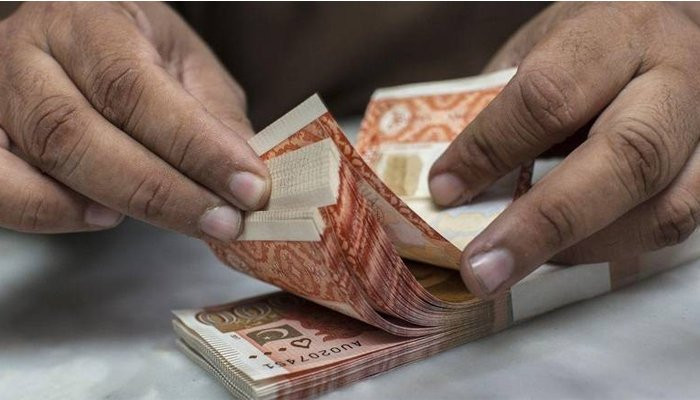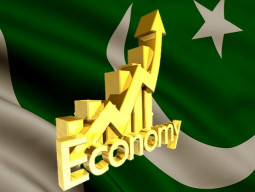
The Pakistani currency dropped 0.62% (or Rs1.14) to a new historic low beyond the important threshold of Rs185 against the US dollar in the inter-bank market on Tuesday owing to sharp increase in trade deficit and the rumour that the International Monetary Fund (IMF) has placed $6 billion loan programme on hold.
The steep depreciation in domestic currency is not only feared to slow down the domestic economy but also projected to trigger a notable surge in yields of T-bills and Pakistan Investment Bonds (PIBs) in secondary markets. It also pushed gold price to all-time high of Rs132,000 per tola (11.66 grams) in the country.
The domestic currency hit a record low of Rs185.23 against the greenback on Tuesday compared to Rs184.09 on the previous working day on April 1, according to the State Bank of Pakistan’s data.
The latest drop in rupee was seen after the Pakistan Bureau of Statistics (PBS) reported a significant surge of 70% in trade deficit to $35.4 billion during the first nine months (July-March) of the current fiscal year 2022 compared to the same period last year. Besides, the International Monetary Fund (IMF) placed the ongoing $6 billion loan programme on hold for the third time in wait for the new government.
The IMF, however, clarified that it would engage to promote macroeconomic stability and looked forward to continue its support to Pakistan.
The rupee has maintained non-stop downward streak for the 15th successive working day except on March 24 when it closed flat compared to the previous day’s closing.
Accordingly, the domestic currency has cumulatively lost 3.76% (or Rs6.72) in the past 15 working days to date from Rs178.51 on March 11.
Cumulatively since the start of the ongoing fiscal year, the rupee has dropped by a massive 17.58% (or Rs27.69) compared to previous fiscal year’s close at Rs157.54 on June 30, 2021.
“The surging import bill and debt services (interest payments) have kept rupee under pressure,” BMA Capital Deputy Head of Research Abdul Rehman said while talking to The Express Tribune.
The super cycle of global commodity prices, mainly of international crude oil price, has kept the country’s import bill on the rise, while exports have remained low despite some growth. “The trade deficit has widened by a massive 70% in the first nine months of FY22,” he said.
The increased trade deficit suggests that the current account deficit would rebound to higher side for March 2022 as “Pakistan remains a (net) petroleum oil importing nation,” he said.
Besides, the nation also heavily relies on imported cooking oil and steel whose prices have also maintained uptrend in recent times.
Secondly, Pakistan has continued to repay notable amount of foreign loans and paid debt servicing as well in the recent weeks. “The import bill and foreign debt repayment has taken a toll on the country’s foreign exchange reserves,” he said.
The country’s (SBP) reserves have declined to two-year low of around $12 billion in the week ended on March 25, according to the latest weekly update of the central bank made on Thursday.
The reserves have kept depleting for the past six to seven consecutive weeks. “The reserves have dropped by 10% in the current calendar year 2022 to date (March 25),” Rehman said.
Bond yields
The yields on three to 12-month T-bills increased in range of 13-19 basis points to 11.87-12.57% in the secondary market on Tuesday.
Similarly, the yields on three to 10-year PIBs rose by 21-35 basis points to 12.09-12.45% in the secondary market.
Gold price
The gold price surged Rs800 per tola to an all-time high of Rs132,000 in Pakistan.
This is for the third time that the bullion prices shot to the current price since August 2020, but never surpassed the level till to date, it was learnt.
The increase in the rate is mostly seen due to depreciation in rupee, as Pakistan meets its all the demand for gold through imports.
It improved $2 per ounce (31.10 gram) to $1,928 at world markets, All Sindh Saraf and Jewellers Association reported.
Published in The Express Tribune, April 6th, 2022.
Like Business on Facebook, follow @TribuneBiz on Twitter to stay informed and join in the conversation.

1736938320-0/BeFunky-collage-(52)1736938320-0-405x300.webp)

1736235029-0/diddy-(50)1736235029-0-165x106.webp)
1736930668-0/Untitled-design-(97)1736930668-0-165x106.webp)
1736931444-0/BeFunky-collage-(51)1736931444-0-165x106.webp)






1732012115-0/Untitled-design-(14)1732012115-0-270x192.webp)
1736844405-0/Express-Tribune-(2)1736844405-0-270x192.webp)










COMMENTS
Comments are moderated and generally will be posted if they are on-topic and not abusive.
For more information, please see our Comments FAQ